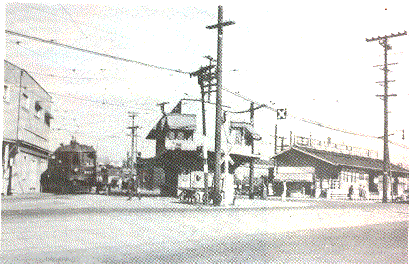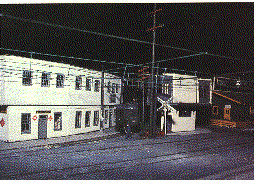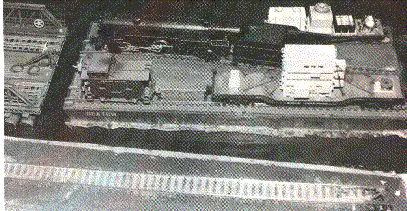
This article is the first in a series regarding the Achievement Program. The authors will be various Master Model Railroaders. Other topics scheduled include Chief Dispatcher, Electrical Engineer, Structures, Author and Cars.
An explanation of the AP and all the certificate requirements, including definitions were printed in the October 1990 issue. For further information, contact your division or regional AP Manager. Or peruse the NMRA on the Web, Achievement Program pages.
Our goal is to encourage members to actively participate in contests and the AP. Our objective is to describe specific features of a certificate. The purpose of these artides is to advise and assist all members to earn a Merit Award. The interpretation covered, along with pictures and helpful hints may clarify the certificate requirements so you can enjoy the recognition award (AP Certificate) for your demonstrated skill.

A head-on view of the junction. Repair shops are on the left, the triangular building in the center formerly housed the auditor's office and the accounting department. The first floor was occupied by the baggage room, store room and trainmen's locker room. Here also was the Westinghouse electro-pneumatic interlocking plant with 11 active and 12 spare levers. (Photo courtesy Interurban Press}
Let's look at this pages's topic: Prototype Modeler. In March 1987, Category 4A, building a prototype scene was initiated from a concept recommended by MMRs Bill Ehlert and C.J. Riley to encourage modular builders and prototype modelers to participate in the Achievement Program. This certificate involves those interested in research and all phases of modeling of a prototype scene. Since Category 4 covers building scenery (the most popular craftsman certificate) the judging items are the same, but the scoring points per item are different.
The scoring emphasis is on the structure's prototypical appearance and scenic representation to the actual plan/photograph.
A bonus for this category is that the motive power, cars and structures used to demonstrate the scene may also qualify for those individual certificates. So, it would be wise in your planning to construct these models in accordance with those requirements. What a deal!
The theme of the 1990 National Convention in Pittsburgh was "Learning from The Prototype." Many clinics dealt with prototype modeling. The presentation papers (298 pages) were published in a "Blue Book." It is a valuable resource, especially for a PM, and is available from our Library.
Let's hear from the masters on how they met this challenge to earn one of the most difficult certificates.
First you need to select a prototype scene from a documented plan/photograph. This is most likely from a book(s) or magazine(s); and don't overlook NMRA Kalmbach Memorial Library. However, if the scene is within your travels, pay it a visit, armed with notebook, sketchpad and camera. Make a record of several outstanding features and the unique scene we plan to replicate. If anyone is around to talk to, not only ask their permission to go on the property and explain what you're doing, but ask them about the railroad, get some inside information and historical facts. Also make a sketch of the track plan, take note of terrain details, take pictures of rolling stock, rail and non-rail structures. On this subject, MMR Al Means uses a 10-foot-long pole with one-foot black-and-white stripes in the picture for verifying size for modeling. In a case like the Sacramento Northern, this road ceased to exist over 40 years ago, and all of the features are long gone. How lucky we are, in situations like this, some farsighted soul documented the road sometime prior to its demise, then published magazine articles and books, replete with text and photographs of the equipment and various scenes.
A major item in this category is documented evidence. Therefore you must have plans/maps/pictures for verification. These will be used by the judges (photocopies must be provided with the mailed Statement of Qualification).
One will do if it contains all the elements needed for the scene. For the Brooklyn Eastern District Terminal (BEDT) wharf area at Kent Avenue Mike Collins provided two maps and 15 pieces of data (pictures and text) from five books, six magazines, a railfan handout, including a picture postcard. This might be considered overkill. However, the judges had no problem with verification. Having more than "one" picture reflects your level of research for this prototype, a positive attitude in your favor.

With all of this at hand, sketch out the ideas for a track plan which will depict a section of the road covering the items required in the regulations. Now let's clear up a little confusion: You have the option of what season you want to model, the weather conditions, the time of day, the day and year.
When the research and planning phases are completed, the next step is . . .
The size of the scene should fit a module, display (diorama) or piece of your layout large enough to display the scene. Unless, like MMR Jack Burgess with his Yosemite Valley Railroad (related information published in the "Blue Book LEARNING FROM THE PROTOTYPE), your entire layout is prototypical.
The six models needed include four different types, freight car, railroad structure, caboose/passenger car and locomotive. Here are some more items that may help. If the prototype picture shows more than one locomotive, you only need to model one. You don't need to have more than one, since locomotives would vary during the day. If no locomotives are shown in the picture, a model locomotive of that time and road which operated there must be added (verification would be necessary). If the prototype picture shows an RDC, interurban, gas-electric, Doodlebug or trolley, this will qualify for both motive power and passenger car for this category, but you still need six models.
All these models must be compatible to the scene and time frame.
When constructing these models, be sure they meet the definitions of scratchbuilding and super-detailing since two must be scratchbuilt, the remainder super-detailed. In many cases these models will earn a Merit Award in their category. Although this is not essential. However, with high quality models in the scene, the overall scoring will naturally be higher.
Since lighting will affect your score (maybe enough points needed to pass), add whatever lights shown in the scene, such as streetlights, yard, loading dock, signals and building interior if a night scene.
For the background, you will need to reflect the area. The size and quality of the backdrop should frame the scene so there is no doubt where the scene is located. This can be something simple like the sky or there may be a need for a complex city-scape. The key words are: skillful and artistic treatment of the backdrop to realistically represent depth, distance, including obscuring unnatural openings and obstructions. You may need some of the 15 points allotted in this area.

The Lehigh Valley tug has backed away at the BEDT, Williamsburg Section of Brooklyn for a photo by Mike Collins of his required six models... a modified kit float bridge, a super-detailed locomotive, scratchbuilt Merit Award models... caboose, flatcar, depressed flat and car float.
After all of the details are added, now compose (type or print) a carefully edited Statement of Qualification (SOQ). The SOQ must contain all the required information and items listed in the regulations. When everything is organized, we're ready for the AP judges. (Refer to the article on Judging Prototype Models). Each phase of the rules is checked for compliance. After tearing our work apart, finally our score exceeds 87.5 points. In our relief, the SOQ receives their signatures. We have passed the critical step. If you don't pass, be sure to get constructive criticism and advice from the judges in order to correct the deficiencies.
Photos must be taken (either before or after judging) of the six models as they appear on site, along with overall scenic shots, some taken at the same angle to compare to the prototype picture(s). Either mount the model verses prototype pictures side-by-side, or key the pictures with numbers/information. Example: "#I Model 'X' picture, see prototype photo #1 (reference source); #2 Model 'Y' picture, see prototype photo #5, #6 and #8; #3 Model 'Z' picture, see #12 and #3."
Between the pictures and the paperwork you will end up with a package of 13 to 45 pages. The minimum being:
Make copies of everything in case something gets lost en route in processing your package.
After the "handout" (or mailing) to the next level in the AP, sit back, enjoy your miniature recreation of a prototypical railroad setting - and wait!